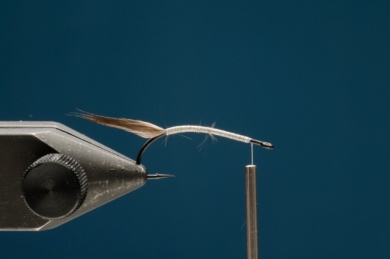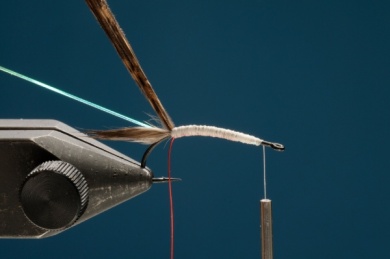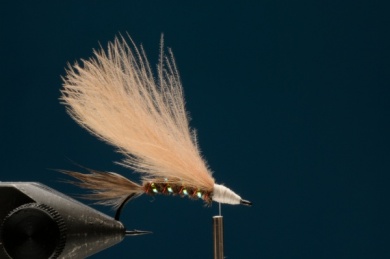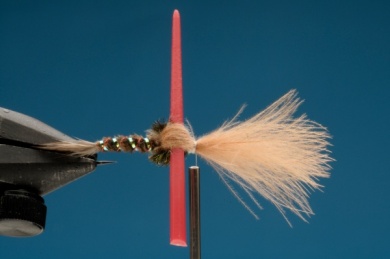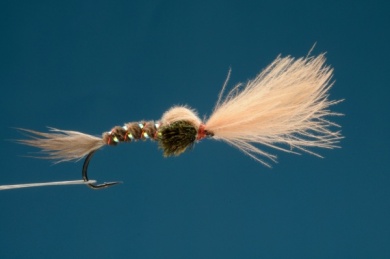The way in which we tie CDC in this emerger –as seen in the picture that shows it in action- makes the abdomen have the correct posture when on the water. The air bubble that takes form below the CDC wing case prevents the thorax from sinking, leaving the abdomen in a less effective vertical posit View more...The way in which we tie CDC in this emerger –as seen in the picture that shows it in action- makes the abdomen have the correct posture when on the water. The air bubble that takes form below the CDC wing case prevents the thorax from sinking, leaving the abdomen in a less effective vertical position than if inclined. We can also see that a pressure cone is created on the surface when it emerges, and this has an interesting effect in the colors of the fly when seen from below. That cone acts as a prism that decomposes the light, making red, green and orange colors highly visible. The remaining CDC that moves towards the front of the fly perfectly imitates the mayfly adult as it comes out from its nymph case.The marabou tail gives great moves to the emerger, resembling a live being. We should make a double ribbing in the abdomen to simulate in a more perfect way the highlights and the colors that are seen from under the water when something is trapped on the surface. These are clearly seen when we watch a real fly from under the water on an aquarium or with diving goggles.
Move the mouse over the image to zoom in the fly.
Touch the image to zoom in the fly.

List of materials
MaterialsHook: Partridge YK125ST, black Sedge type. Because of its shape and color it is a part of the design of this emerger, making one only piece with the abdomen.Thread: 8/0 or 14/0, white.Abdomen: six brown peacock fibers, clearly barred. Natural color or dyed olive.Ribbing 1: one pearled Flashabou Mirage strip, or pearled with green highlights.Ribbing 2: red, very fine copper wire.Thorax: peacock fiber; bronze colored if possible, like the feather with the eye mark. That color can be obtai View more...MaterialsHook: Partridge YK125ST, black Sedge type. Because of its shape and color it is a part of the design of this emerger, making one only piece with the abdomen.Thread: 8/0 or 14/0, white.Abdomen: six brown peacock fibers, clearly barred. Natural color or dyed olive.Ribbing 1: one pearled Flashabou Mirage strip, or pearled with green highlights.Ribbing 2: red, very fine copper wire.Thorax: peacock fiber; bronze colored if possible, like the feather with the eye mark. That color can be obtained by leaving the peacock feathers behind a window and exposed to the sunlight. Discoloration from green to copper-bronze with intense reddish highlights, much more effective than the original green color.Wing Case and Wing: four CDC feathers with the color that matches the mayfly. In this case, I use a beige color to imitate Siphlonellas adults and some large Leptophlebias.
Steps
Step 1
Tie some thread from the hook eye to the bend and place a tail made by marabou-like strips (those found in saddle hackles). I prefer the natural grey color.
Step 2
Go back with some open turns towards the hook eye, and tie the six peacock strips, the flashabou and the copper wire, going towards the bend and up to the tail edge.
Step 3
Without wrapping the peacock strips making them bulky, we should cover them with anti-clockwise moves; then tie them and trim. We should do the same with the flashabou strip that goes around the abdomen. After tying with copper wire and trimming the flashabou, cover it with clockwise moves. This way we go through the body and the flashabou ribbing making an X-figure, and set both tightly in a single step. View more...Without wrapping the peacock strips making them bulky, we should cover them with anti-clockwise moves; then tie them and trim. We should do the same with the flashabou strip that goes around the abdomen. After tying with copper wire and trimming the flashabou, cover it with clockwise moves. This way we go through the body and the flashabou ribbing making an X-figure, and set both tightly in a single step.
Step 4
Even out four CDC feathers (you can use 2 or 3 for smaller flies) and tie them with its concave side heading up, making sure that we leave enough of it at the back so that it is not short when bent over the thorax. The length of it, that overhangs, should be at least of the same length as the abdomen.
Step 5
Take a peacock fiber with long fibrils, tie it by its tip (cut off the thinner section), and cover the thorax by combing the fibrils towards the back (as we do when tying a hackle). It should be very thick.
Step 6
Use a toothpick to keep the CDC feathers from sticking completely on the thorax when tying them at the head. This little gap will then hold an air bubble that forms when the fly gets to the water, and it will keep the fly in the correct angle of inclination. Finish this emerger fly by dying the tying thread with brown marker and making several turns right below the wing. These finishing turns should make the fly a bit more tilted upwards. View more...Use a toothpick to keep the CDC feathers from sticking completely on the thorax when tying them at the head. This little gap will then hold an air bubble that forms when the fly gets to the water, and it will keep the fly in the correct angle of inclination. Finish this emerger fly by dying the tying thread with brown marker and making several turns right below the wing. These finishing turns should make the fly a bit more tilted upwards.
Step 7
Finished fly image.
